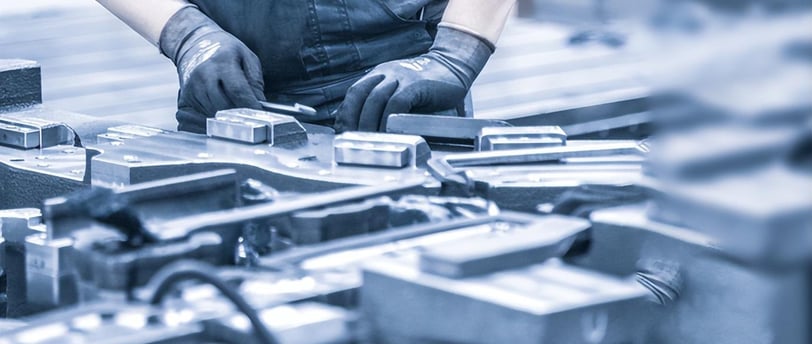How to Optimize the Performance of Stamping Dies Through Material Selection
2/10/2025


Understanding Stamping Die Materials
Stamping dies are crucial components in various manufacturing processes, and the selection of the right materials for their construction is vital for optimizing their performance and longevity. The most commonly used materials for stamping dies include tool steels, carbides, and aluminum, each offering distinct properties that influence their effectiveness in different applications.
Tool steels are a popular choice due to their hardness and wear resistance. They are generally classified into various grades, with D2 and O1 being some of the most frequently utilized for stamping dies. The high carbon content in tool steels provides excellent hardness after heat treatment, making them suitable for applications involving high wear. However, while tool steels excel in hardness, their toughness is relatively lower, which can be a drawback in applications that require significant impact resistance.
Carbides, often regarded as the premium choice for stamping die materials, excel in both hardness and wear resistance. These materials are typically used for manufacturing dies that demand exceptional durability, particularly in high-volume production environments. Carbides can withstand aggressive wear conditions but may be more challenging to machine and modify due to their brittleness. This limitation can increase production costs and require more skilled labor for fabrication.
Aluminum is another viable option, primarily due to its light weight and ease of machining. While aluminum does not offer the same level of hardness or wear resistance as tool steels or carbides, it can be advantageous in applications where die weight plays a critical role, such as in portable stamping operations. Additionally, aluminum's good machinability allows for rapid prototyping and design modifications. However, it is essential to recognize that aluminum may not hold up in high-impact scenarios.
When selecting materials for stamping dies, key factors such as hardness, wear resistance, toughness, and machinability play crucial roles in influencing overall performance. Understanding these properties allows manufacturers to make informed decisions that align with their production needs and operational goals.
Factors Influencing Material Selection
The selection of materials for stamping dies is a critical decision that significantly impacts the overall performance and longevity of the dies. Several key factors must be examined to ensure that the chosen materials meet the specific requirements of the stamping process effectively. One of the primary considerations is the type of metals being stamped. Different metals exhibit varying ductilities, hardness levels, and tensile strengths, which can directly affect die wear and the quality of the stamped products. For instance, stamping materials like aluminum and steel may necessitate distinct considerations in terms of material hardness and wear resistance.
Another crucial factor is the production volume. High-volume production may warrant the use of more durable materials to minimize wear and reduce downtime associated with maintenance or replacement. In contrast, for low-volume applications, cost-effective materials may be preferred, allowing for a balanced approach between longevity and expense. This leads to the consideration of complexity in die designs. Intricate designs often require materials that can withstand higher stresses and strains, while simpler designs may suffice with more commonplace materials.
Cost-effectiveness is also an essential aspect of material selection. While premium materials may offer superior performance, their associated costs can be prohibitive. It is thus vital to consider whether the benefits in durability and performance will justify the potential increase in expenditure. Understanding the operational conditions, such as stamping speed and environmental factors, further influences this decision. High-speed stamping environments may require materials with enhanced hardness to withstand increased abrasion, whereas less demanding conditions might allow for more economical choices.
By carefully evaluating these factors, manufacturers can make informed decisions regarding the selection of materials for stamping dies, ultimately optimizing performance and operational efficiency.
Best Practices for Material Selection
Choosing the right materials for stamping dies is a critical step that directly impacts their performance and lifespan. One of the best practices is to conduct thorough material testing, which aids in identifying how different materials will behave under specific operational stresses. Testing can reveal how the material withstands wear, the pressures of stamping processes, and the effects of heat and corrosion. Implementing a systematic approach to testing helps ensure that the selected materials will meet the demands of the intended stamping application.
Another vital aspect of material selection involves considering heat treatment processes. Heat treatment can significantly enhance the mechanical properties of materials, improving hardness, tensile strength, and resistance to fatigue. It is essential to evaluate the heat treatment options suitable for the materials under consideration to achieve optimum performance. Understanding the relationship between material properties and processing methods will allow manufacturers to make more informed decisions regarding material selection for stamping dies.
Collaboration with material suppliers is also key. Engaging with experts in material science can provide valuable insights into the latest developments and innovations available in the market. Suppliers may offer guidance on selecting materials specifically optimized for stamping applications while also providing data on material characteristics and performance metrics. Regular communication with these experts helps manufacturers stay updated and make the best choices in their material selection processes.
However, it is important to avoid common pitfalls during material selection. One mistake is solely focusing on cost without considering long-term performance implications. Selecting cheaper alternatives may lead to higher maintenance costs and production downtimes, ultimately undermining the value of the stamping dies. Additionally, neglecting to account for compatibility between different materials can result in premature failure or inefficiencies. By adhering to these best practices, manufacturers can significantly enhance the performance and durability of their stamping dies.
Case Studies in Material Optimization
Examining real-world applications of stamping die performance optimization through material selection reveals valuable insights that can benefit various industries. One notable case involved an automotive manufacturing company that experienced frequent die failures due to wear and tear. The frequent downtime was significantly impacting production rates. The team decided to switch from a conventional tool steel to a more advanced high-speed steel (HSS) that provided better wear resistance and toughness. Post-implementation, the results were remarkable—tool life increased by 40%, and the overall efficiency of die production improved, illustrating the importance of innovative material choices.
Another example is found in the consumer electronics sector. A company producing intricate sheet metal parts faced challenges with their stamping dies as the complexity of designs increased. The original die materials were not performing adequately, leading to dimensional inaccuracies and surface finish issues. The solution involved utilizing carbide-based materials, specifically designed for high-precision stamping applications. This strategic selection significantly enhanced surface integrity and dimensional stability, resulting in a substantial reduction in rework and scrap rates. The long-term performance of the stamping dies saw an improvement of over 30%, which also led to cost savings for the manufacturer.
A third case study highlights a manufacturer in the aerospace industry, where the requirements for stamping die durability are exceptionally stringent. Faced with high production demands, this company opted to use a specialized aluminum alloy as the die material. This choice was not only lightweight but also provided the fatigue resistance necessary for the rigorous stamping processes. The implementation of this material resulted in improved productivity and a remarkable extension in die life span by approximately 25%. These case studies underline that strategic material selection is vital in enhancing the operational efficiency and longevity of stamping dies across diverse applications.
